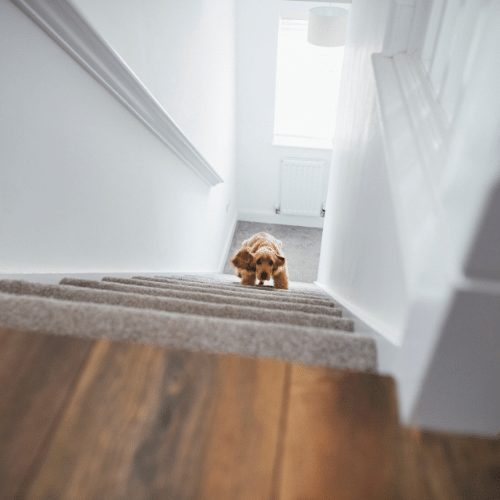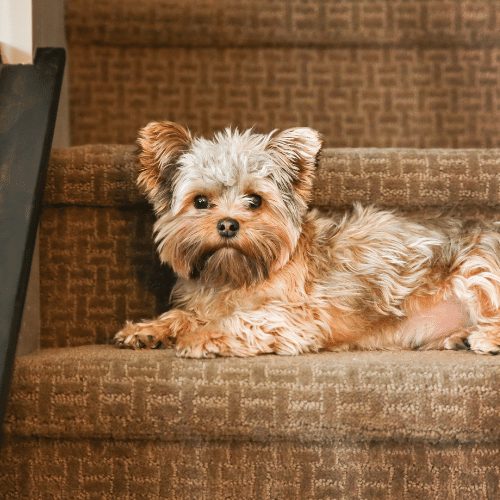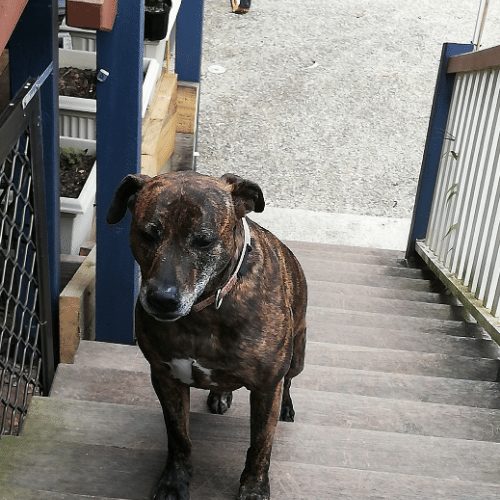Old dogs and stairs
April 26, 2021 2022-01-20 19:50As your pup is aging, you will probably notice that moving up and down the stairs is tricky for him. Maybe he slips when trying to climb up or down – or he just outright refuses to use the stairs anymore.
If your dog is a high-energy breed, he might also try to push through the discomfort of climbing stairs, making you worried for his safety.
Let’s discover if dogs should stop using stairs, and how you can help your senior dog navigate any staircases securely without risk of injury.
Table of Contents

Are stairs bad for older dogs?
Staircases in general are not the safest part of the home for our pups. They pose a lot of potential risk factors, not just for senior dogs.
Young puppies should not be allowed to climb staircases due to the risk of overuse of their joints. But even when they reach adulthood, stairs can be dangerous!
Adult dogs often become too rambunctious and energetic and can slip and get injured climbing up and down the staircase. Racing and sliding up and down staircases can lead to injuries of knee, hip and shoulder ligaments.
While the internet is full of “funny” videos of dogs slipping on and falling down stairs, they are really not that funny or lighthearted. Dogs of any age – not just older dogs – need to be taught to navigate stairs slowly and carefully.

Risks
As dogs age, their joints become stiff and at times painful – just like in humans. The more range of motion is needed for any activity, the more likely it is that this will hurt the dog. When climbing up stairs, a lot of weight is put onto the hips. Hips are one of the joints most likely to develop arthritis in dogs. While putting your senior dog on a supplement can help slow down the progression of this disease, it cannot reverse it.
Climbing up stairs with arthritic hips will be uncomfortable for your dog, and you may even notice stiffness or reluctance to get up after your dog has climbed several sets of stairs. It can significantly reduce the zest he has for life.
On the other hand, climbing down stairs strains the dog’s shoulders. This is comparable to the knee pain we humans can feel when walking down a steep hill. If your dog’s shoulders have been subjected to a lot of impact throughout his life (e.g. because he has played a lot of fetch, or he is a retired agility dog), this can be especially uncomfortable for him.
In addition to the momentary discomfort, climbing or descending stairs can also increase long-term joint or back issues in older dogs. Dogs can get slipped discs in their back just like humans. If these are noticed too late, they can even leave your pup paralyzed.
How do I get my senior dog to go down the stairs?
If your senior pup already refuses to go down the stairs, you can be certain that he is experiencing discomfort while doing so. He may also have slipped in the past (unbeknownst to you) and now be scared about sliding again.
The best course of action is to set up your dog’s environment in a way that he does not have to go upstairs. Move his bed, water and food bowls to the ground floor. This way you keep him from being uncomfortable while at the same time preventing further injury to his joints.
If your house or apartment is set up in a way that your dog has to navigate stairs, you should try to make them as secure as possible for your pup. Put down some carpet on the steps and also on the floor beneath the stairs. Simply having secure footing can already make your dog happier to go down the stairs. In addition, you might want to ask your vet for some medicine to keep your pup’s joint pain at bay and manage his comfort level.
For small to medium sized dogs, just switch to carrying your pup up and down the stairs. He will be much more comfortable if you do so!
Are stairs or ramps better for older dogs?
Ramps are much better for older dogs!
Unfortunately, most indoor staircases cannot be replaced with ramps. However – if you have the opportunity to swap any staircase in your dog’s life for a ramp, do so. This for example works well for dogs that are using a doggy staircase to get on their owner’s bed at night. If you have stairs in your yard and can replace them with a ramp, you should take this step as well.
The strain on hip and shoulder joints is much less when walking up and down a ramp, compared to a staircase.

Is it bad for old dogs to go up and down the stairs?
Even if your dog does not yet show any discomfort or reluctance to go up and down the stairs, you should try to minimize how often he uses them in any case. Especially high-energy breeds such as herding dogs may hide or ignore pain. You cannot assume that simply because your dog does not refuse to use the stairs, he is perfectly fine with them. He might be motivated to get to the bottom of the stairs because he knows he will get fed or go on a car ride. Motivation can override a lot of pain in dogs.
While using the stairs occasionally will most likely not do much damage for your dog, it certainly won’t make him feel better, either. As dogs are aging, aches and pains pop up across their body, and we should take any steps we can in order to maximize our dogs’ wellbeing.
The bottom line
Stairs are not the safest part of the home for dogs in general. Not only is the repetitive motion hard on aging dogs’ joints, but our pup can slide and get hurt as well. Dogs of all ages should be taught to use stairs carefully and to not race up and down.
For your senior dog, you should avoid staircase usage as much as possible. If you live in a two-story home, bring all of your dog’s belongings (beds, blankets, toys, bowls etc.) to the ground floor. That way he does not have to go up and down.
If it is not possible to have your dog stay on the ground floor (such as because you live in an apartment), you can make the stairs safer by putting some carpet or non-slip tape on them. If you own a small dog, you should just carry him up and down.

